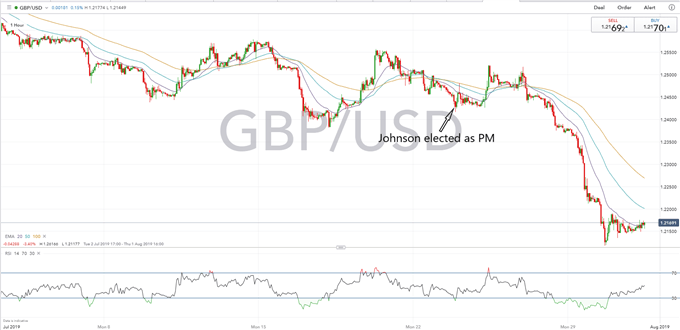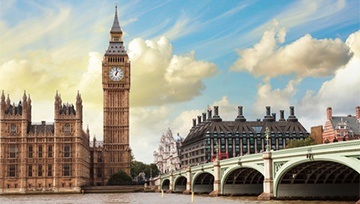Brexit Backstop & The GBP - Talking Points:
- Boris Johnson strongly opposes an agreement that includes the Irish backstop, increasing the likelihood of a ‘no-deal’ outcome and weighing heavily on the Pound
- Despite assurance from the EU that the backstop would only be temporary, UK MPs are not convinced that would be the case
- Unionist MPs are concerned about the threat the backstop poses to the Good Friday Agreement
Brexit Timeline – How negotiations have affected the markets
The Brexit Withdrawal Agreement hashed out between former Prime Minister Theresa May and her EU counterparts at the end of 2018 was rejected three times in Parliament at the beginning of the year mostly because of large opposition to the backstop clause. This has in turn led current Prime Minister Boris Johnson to reject the acceptance of a deal that would keep the backstop in place – a fundamental impasse for the EU on any acceptable resolution.
But What Exactly is The Brexit Backstop?
The backstop is a legal agreement that would allow for continued free movement of goods, services and people between Northern Ireland and the Republic of Ireland, which would help local industries remain prosperous. It is essential to work out the status of the Irish Border after Brexit takes place, as it would regulate trade among the only land border between the EU and the UK. The sticking is that if the backstop was triggered it would treat Northern Ireland differently from the rest of the UK, which is something the DUP strongly opposes.
In order to avoid lengthy and costly checks at the border, the EU and UK hope to reach a trade agreement that will govern their relationship regarding the movement of goods across this particular border. But until the agreement is reached - if it is reached at all - the Brexit backstop would theoretically come in to account to avoid a hard border from raising equally-difficult diplomatic problems.
Boris Johnson is The New UK PM - What Next for Sterling (GBP)?
The Good Friday Agreement
Coming into effect in 1999, the Good Friday Agreement (GFA) is a major political development in the peacekeeping in Ireland that governs the relationship between Northern Ireland’s political parties and the relationship with the Republic of Ireland and Great Britain. In the agreement, the Republic of Ireland acknowledged that Northern Ireland was a part of the United Kingdom, something that unionist MPs believe the backstop is threatening to disrupt by dividing Northern Ireland and mainland Britain.
The issue with Brexit is that the GFA is in proper effect if the UK and the EU are bound by the same single market rules; but if the UK were to leave the Customs Union, it would mean that the Ireland border would no longer be an internal border of the EU, but a matter of international trade. Under this new scenario, goods and services moving between the Republic of Ireland and Norther Ireland would need to be governed by EU levies and tariffs, as the UK would no longer sit within the free trade area. And although the UK government has sought legal advice that reassures that the Irish backstop would not breach the GFA, it remains the main point of conflict between politicians.
Why is The UK Government Against the Brexit Backstop?
The Withdrawal Agreement was reached in November under Theresa May’s government and included a backstop agreement. MP’s feared that this backstop would block the UK from making its own trade deals by keeping the UK within a customs union. Boris Johnson told MPs that “no country that values its independence - and indeed its self-respect - could agree to a treaty which signed away our economic independence and self-government as this backstop does”.
The EU has promised the backstop would only be temporary and it will only be enforced in the case where a trade agreement is not reached, but the UK government has not been convinced by the fact that there is no time limit on the legal agreement. In January 2019, in an attempt to get the deal passed in the British Parliament, the EU gave legal force to a letter from Jean-Claude Juncker and Donald Tusk whereby they stated that the EU’s intention was to avoid triggering the backstop if it could be avoided. And, if not possible, it would only be in force for as long as necessary without any need for the commitment to a longer-term, default obligation. But this failed to convince the UK’s attorney general Geoffrey Cox, as although it reduced the risk of the UK being ‘trapped’ in the backstop, it did not eliminate it completely.
Boris Johnson went on to say “a time limit is not enough. If an agreement is to be reached, it must be clearly understood that the way to the deal goes by way of the abolition of the backstop”. Chief EU Brexit negotiator Michel Barnier replied to these sentiments with “PM Johnson has stated that if an agreement is to be reached it goes by way of eliminating the backstop. This is of course unacceptable and not within the mandate of the European Council.”
What are The Other Alternatives?
Given that neither party seems ready to back off before the deadline to achieve a new withdrawal agreement, other options the EU currently has in place with other countries are also available.
A Norway-style agreement would allow the UK to cease being a member of the European Union but remain within the European Economic Area (EEA) and the single market, which would mean that trade relationships with the EU would remain unchanged. This in turn would require the UK to comply with EU rules and regulations and make contributions to the EU budget, but the UK would no longer be under the European Court of Justice or have to be a member of policies that govern certain industries like fishing and farming. Being excluded from the customs union would allow the UK to create its own trade deals outside of the EU, but this would not solve the Irish backstop issue as a customs union or trade agreement with the EU would need to be created in order to avoid a hard border.
But with this option also rejected by the British Parliament and neither the UK nor the EU having started efforts to implement border controls in the case of a no-deal Brexit, the question is who will be the one to install the border posts if the EU insists that it is necessary.
Brexit Uncertainty Drags on the Pound
As Brexit uncertainty continues to drag on the Pound, the fast approaching October 31 deadline decreases the likelihood of a new deal being agreed on in time to ensure that a hard Brexit is avoided. GBP has been in a steady decline since Boris Johnson was elected as new Prime Minister as his “do or die” rhetoric keeps investors concerned about the future of the British economy.
PRICE CHART: GBP/USD TUMBLES AS JOHNSON IS ELECTED PM (JULY 1 – JULY 31, 2019)

Recommended Reading
Where UK Monetary Policy has Failed- Andrew Sentence, Podcast
Eurozone Debt Crisis: How to Trade Future Disasters – Martin Essex, MSTA, Analyst and Editor
KEY TRADING RESOURCES:
- Just getting started? See our beginners’ guide for FX traders
- Having trouble with your strategy? Here’s the #1 mistake that traders make
- See our Q3 forecasts to learn what will drive FX the through the quarter.
--- Written by Daniela Sabin Hathorn, Junior Analyst
To contact Daniela, email her at Daniela.Sabin@ig.com
Follow Daniela on Twitter @HathornSabin






